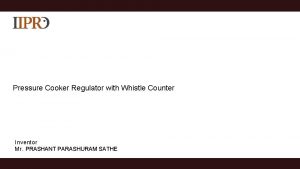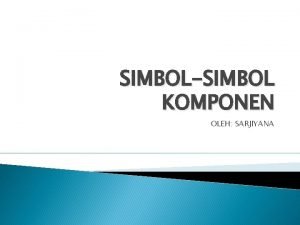Pressure Cooker Regulator with Whistle Counter Inventor Mr









- Slides: 9

Pressure Cooker Regulator with Whistle Counter Inventor Mr. PRASHANT PARASHURAM SATHE

Technical Field of Invention This invention is built to function in the field of pressure cookers, by providing for a pressure cooker regulator with a highly responsive whistle counter. It helps in achieving greater control over the rate at which food cooks. This invention also reduces the extent of intervention required in monitoring the food being cooked in the pressure cooker, thus allowing one to multitask in the kitchen. IPR Status: Application Number: 201621018465/WO 2017208127 A 1/PCT/IB 2017/053135 Patent Pending Priority Date: 30 May 2016 Key Advantages of Investing in Early Stage: 1. Investing in the initial stage of such an exceptional technology is an opportunity to get licensing rights at an extremely cost efficient price and at more favourable terms. 2. It provides flexibility for the modification as per requirements. 3. Involvement of investor's Research and Development expertise, would further enhance the quality of product.

The Problem ● The invention overcomes the ambiguity and greater amount of attention required that is associated with most recipes measuring the time of cooking required in ‘whistles’ (when the pressure built up in the cooker is released from the vents of the cooker. ● Overcooking, loss of nutrients, waste of energy and gradual cooker or gasket failure are common issues affecting pressure cookers. ● This Pressure Cooker Regulator is an advantage over other pressure cookers in terms of the extremely clear visual & sonic aids it offers to indicate the beginning, middle and end of the cooking process.

Introducing the Regulator with Whistle Counter: ● The proposed invention relates to pressure regulators used in pressure cookers. The invention operates through the interplay of a dead weight cylinder, pin, an inner cylinder and steam vents. Through the upward and downward movement of the pin, the dead weight cylinder and pin, stream pressure release events occur which kickstarts a parallel process where the inner cylinder, a follower pin and the sawtooth arrangements on its peripheries rotate the dead weight cylinder in steps causing its angular displacement in gradations. ● The window on this cylinder and the dial on the inner cylinder serve to display the total number of pressure release events or the decrements left in the same. Due to the displacement of the dead weight cylinder, the window moves over the numerals contained in the dial. ● The proposed invention is inexpensive, durable and simple. It allows a user cooking to slow down the cooking process, and at the same time alert them about the important events in the process of cooking food in the cooker which will allow them to focus on other tasks at the same time.

Working Overview ● The pressure regulator can include a dead weight cylinder and an inner cylinder that are concentric to each other, wherein the dead weight cylinder can be operatively coupled with a pin that can be configured along common axis of the dead weight cylinder and the inner cylinder such that the pin can move up to release the steam from a steam vent when a designed steam pressure is achieved, the steam vent emanating a whistle , can simultaneously raise the dead weight cylinder, and can move down when the steam pressure falls below the designed steam pressure stopping release of the steam. ● The dead weight cylinder can be operatively coupled with a pin that can be configured along common axis of the dead weight cylinder and the inner cylinder such that the pin can move up to release the steam from a steam vent when a designed steam pressure is achieved, the steam vent emanating a whistle, can simultaneously raise the dead weight cylinder, and can move down when the steam pressure falls below the designed steam pressure stopping release of the steam.

In Depth Working ● Figure 1: Pin 106 is configured in a common axis with that of the outer cylinder 102 moves inside a threaded sleeve 108. Pin 106 can move up to release steam from steam vent 114 (thereby raising dead weight cylinder 102 as well) when designed steam pressure has been reached in the cooker, and move down when steam has been released from the cooker signifying a pressure release event and causing the cooker to emanate a whistle. Pin 106 moves in an upward and downward motion inside threaded sleeve, which has a hex nut 110 at the bottom of it through which steam enters through steam holes 112 and creates an upward pressure on the pin 106. ● Figure 2: Cylinder 104 has staggered sawtooth arrangements that form contours on its upper and lower peripheries with offsets 116 and 118. After steam builds up and pin 106 is pushed up, it causes deadweight cylinder 102 and follower pin 120 to also move up. The upper saw tooth arrangement 116 and lower saw tooth arrangement 118 come into play, as the follower pin 120 first moves along the contours of 116, from ‘A’ To ‘B’, giving follower pin 120 and the attached cylinder 102 both, a Rotary motion. Steam vent 114 opens, and the first pressure release event takes place. Cylinder 102 drops, and so does follower pin 120 to position ‘C’ on saw tooth arrangement 118, and following its motion, comes to rest at ‘D’, causing a still further motion to deadweight cylinder 102, thus completing its first step. Process is repeated for next teeth 116 and 118, which in turn rotates window 126 over dial 122 for one whistle.

In Depth Working ● Once the follower pin reaches step 0 on the dial, steam vent 114 remains open for steam to be discharged. Sleeve 108 has a plurality of steam vents 114, however the follower pin 120 and pin 106 do not allow steam to pass from all the vents. Due to only a few remaining outlets for steam, the remaining time and at a higher pitch (because of the consequently higher pressure at which steam is being discharged). In this fashion, the last whistle can be of a longer duration and higher pitch, thereby alerting the user that steam pressure buildup in the cooker has stopped.

Expectations: • Technology transfer fees and royalties • Licensing Target Industry: ● Home Appliances Industry

THANK YOU

















